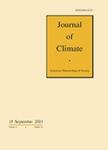版权所有:内蒙古大学图书馆 技术提供:维普资讯• 智图
内蒙古自治区呼和浩特市赛罕区大学西街235号 邮编: 010021

作者机构:Environm Canada Canadian Ctr Climate Modelling & Anal Victoria BC V8W 3V6 Canada Consortium Ouranos Montreal PQ Canada Environm Canada Div Rech Previs Numer Montreal PQ Canada
出 版 物:《JOURNAL OF CLIMATE》 (气候杂志)
年 卷 期:2016年第29卷第1期
页 面:17-35页
核心收录:
学科分类:07[理学] 070601[理学-气象学] 0706[理学-大气科学]
主 题:Physical Meteorology and Climatology Climate change Models and modeling Climate models Regional models
摘 要:A new approach of coordinated global and regional climate modeling is presented. It is applied to the Canadian Centre for Climate Modelling and Analysis Regional Climate Model (CanRCM4) and its parent global climate model CanESM2. CanRCM4 was developed specifically to downscale climate predictions and climate projections made by its parent global model. The close association of a regional climate model (RCM) with a parent global climate model (GCM) offers novel avenues of model development and application that are not typically available to independent regional climate modeling centers. For example, when CanRCM4 is driven by its parent model, driving information for all of its prognostic variables is available (including aerosols and chemical species), significantly improving the quality of their simulation. Additionally, CanRCM4 can be driven by its parent model for all downscaling applications by employing a spectral nudging procedure in CanESM2 designed to constrain its evolution to follow any large-scale driving data. Coordination offers benefit to the development of physical parameterizations and provides an objective means to evaluate the scalability of such parameterizations across a range of spatial resolutions. Finally, coordinating regional and global modeling efforts helps to highlight the importance of assessing RCMs value added relative to their driving global models. As a first step in this direction, a framework for identifying appreciable differences in RCM versus GCM climate change results is proposed and applied to CanRCM4 and CanESM2.